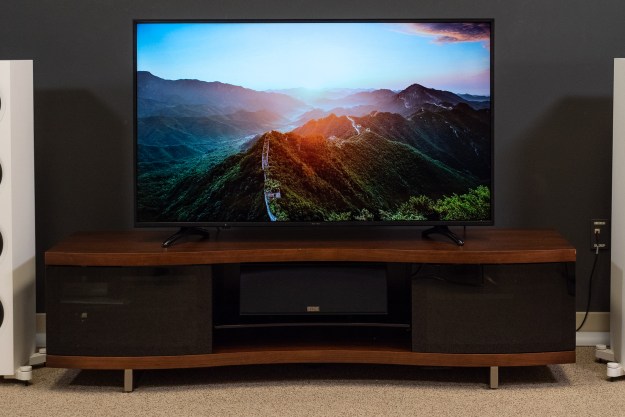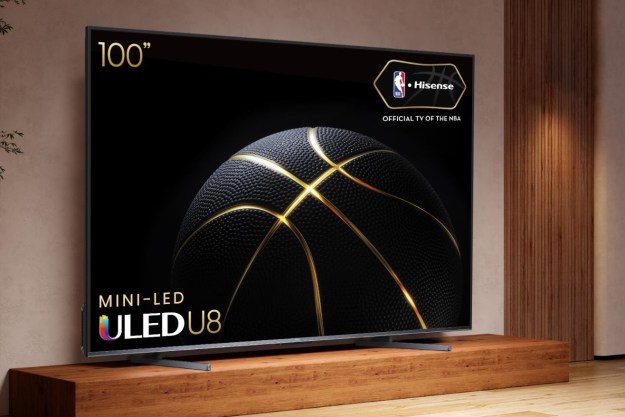
- Good contrast
- Solid black levels
- Slim and light design
- Impressive HDR highlights
- Pedestrian smart interface
- Poor off-axis viewing
- Poor screen uniformity
Budget TVs have come a long way in the last few years. Just look at the latest Roku TVs from TCL: The highly rated 6-series puts up a surprisingly feisty fight against Vizio’s pricier P-series, and even long-established TV brands like Sony, LG, and Samsung.
Hisense H8E series models
- While we reviewed the 55-inch 55H8E model, our review also applies to the 65-inch model.
- 55-inch (55H8E)
- 65-inch (65H8E)
TCL’s biggest homeland competitor, Chinese compatriot Hisense, wants a piece of that action, and its H8E model is designed to take it. While the H8E may not brawl with the big boys yet — especially when it comes to its mediocre smart interface — the TV offers plenty of
Out of the box
The first thing we noticed when unwrapping our 55-inch model is that the cardboard box doesn’t slide off the top like most TVs this size; instead you’ll need to awkwardly hoist the TV out of its foam home. Luckily, the TV is also strikingly light for its size — not always a good sign for an LED TV, but as we learned later, the H8E serves up much of its special sauce in the processing, not the panel.
The TV has a relatively slim bezel with a brushed aluminum finish for a fine posture on your TV stand, and it’s also relatively slim for a backlit display. The shiny plastic feet scream budget buy, though, so those looking to class things up may want to upgrade to a mounting stand.

It comes with all you’ll need, including a rather old-school looking wand remote with a number keypad (refreshing these days, if not a bit oafish), batteries, and a power cable. The H8E features Alexa voice-control for basic functions like input switching and volume adjustment, but the base remote does not include a mic, so you’ll have to either pony up another $40 for the mic remote, or access it through an Echo speaker.
Features and picture setup
As you’d expect in a budget buy, there aren’t a ton of ways to connect. You get just three HDMI inputs to work with, though that matches TCL’s pricier 6-series, so we can’t complain too much, and we were glad to see all of them support
HDR support includes the popular HDR10 format, allowing for enhanced contrast and color shading on supported content. Unlike some TCL TVs, the H8E doesn’t opt for the pricier
Related
When it comes to the picture processing we mentioned above, the H8E offers local dimming with multiple zones for relatively impressive contrast and black levels. The picture looks decent right out of the box using the Theater setting, but to get the best performance, you’ll have to work for it a bit.
First off,
While the TV does a pretty good job serving up rich contrast and relatively solid black levels under the Theater picture modes, as a budget display, there are some quirks and compromises to be made. One of those involves the Sharpness setting, which needs to be set at 2 or below to avoid notable strobing in certain brighter scenes (most obvious during credit scenes).
It’s also a bit difficult to dig up all the details in the darkest scenes without blowing out the brighter ones, as small increments in the Brightness setting change things dramatically. We ended up lowering the backlight level slightly, while nudging up the Brightness to 51 to see all the details in darker scenes, but black levels will suffer and brighter scenes look better with Brightness at 50. Conversely, you can use Adaptive Contrast (we recommend Low) to enhance darker scenes, but again, picky viewers may find brighter scenes don’t look quite as good.
Otherwise, we mostly left the default settings as is, including keeping Local dimming on Low. You can dig deeper into the Expert Settings, of course, but we recommend all but the most advanced users steer clear of these.
Mediocre smarts
Despite our nitpicking above, the H8E’s picture performance is the real bright spot, providing the most value. On the other hand, the smart interface is pretty pedestrian. This is where Roku’s TV OS really gives TCL and other Roku
Overall, Hisense’s smart features are perfectly workable, and we spent plenty of time using the Netflix app to dig up

Performance
Though you’ll definitely want to add a
The golden robes of Kublai Khan absolutely shimmered in his dimly lit throne room.
Watching The Martian on the H8E was a real treat. The stark dichotomy between the blue-neon earth and space station scenes and the rusty red planet is thrilling. The space scenes are also well cast with little haloing, making the climax where Mark Watney is finally rescued as immersive and compelling as ever. While there’s definitely some brighter flush to the wideband bars in a darkened room, there’s really not much to complain about here.
The same goes for Netflix’s Marco Polo, where the golden silk robes of Kublai Khan absolutely shimmered in his dimly lit throne room. The display does struggle with screen uniformity in bright, open sky scenes like the showdown between Khan and his brother, but then again, to a lesser extent, so does TCL’s 6-Series. The show’s darkest scenes, such as the dusk horse race between Polo and the mysterious princess gave the H8E a real test, but overall the TV allowed for full detail without sacrificing clarity and deeper black shading.
The H8E isn’t as bright as some of the competition, so if you love to crank the colors to 11, it may not be the one for you. Like all LED TVs that forego IPS panels, the H8E also struggles mightily with off axis viewing, sapping colors and contrast starkly outside the sweet spot. It’s also worth noting for gamers and sports fans that, unlike the 65-inch model, the 55-inch 60Hz TV does not include motion smoothing (though we almost never use this feature anyway).
On the plus side, while sound isn’t phenomenal, it’s not too shabby either, outdoing even Vizio’s P-Series.
Warranty information
Hisense warranties its TVs for a year, which is comparable to other brands in this category, including Vizio and TCL.
Our Take
While you’ll need to add a
Is there a better alternative?
As you might have guessed, we recommend checking out TCL’s
In addition, one can’t overlook Vizio’s lineup, whose 55-inch E-series TV offers
How long will it last?
At this price we’re not sure this will be the kind of TV that outlasts your car, but the inclusion of
Should you buy it?
For budget shoppers, Hisense’s H8E TV is absolutely worth consideration. If you have a bit more cash at your disposal, however, we recommend stepping up to TCL or Vizio, both of which offer better smart interfaces and plenty of value in their own right when it comes to getting a killer picture on a tight budget.
Editors' Recommendations
- Best Buy TV deals: Save on QLED TVs, OLED TVs, and 8K TVs
- The 7 best TVs for under $1,000 for 2024
- Best Samsung TV deals: Save on 4K TVs, QLED TVs, OLED TVs, 8K TVs
- TCL’s giant 115-inch QM89 is the world’s largest 4K mini-LED TV
- The 5 best HDMI cables for 2024







